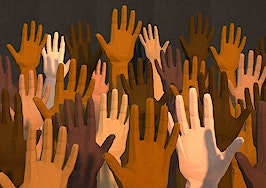This is part three of the series that began with Real (Estate) Talk: What is diversity without inclusion, equity, or justice?
We live in a world where saying “ouch” may lead to a cavalier “sorry,” but the offender does nothing to stop the bleeding and may repeat the offense again and again. That brings to my mind the image of being hit by a car not once, not twice, but again and again with the driver saying “sorry” — yet not taking her foot off the gas pedal. It’s maddening.
Likewise, for many people of color, particularly for Black Americans, there have been sadly just a few times of acknowledgment of injuries made (like denouncing redlining and the unjust razing of predominantly Black communities) without substantive attempts to stop the lingering “aftershocks” and truly repair the injuries.
For example, although redlining is illegal and fair housing is the law of the land, Black and brown homeowners still face unfair appraisal and lending practices, and Black real estate practitioners still face barriers to entry today — yes, in 2021.
Is this a new day for diversity, inclusion, equity and justice in real estate? I believe it can be.
I have had the honor of leading a Be the Bridge Racial Reconciliation group (an award-winning curriculum by Latasha Morrison) at Buckhead Church, which teaches that acknowledgment is indeed important but is truly only the beginning.
Acknowledgment is one of several vital steps to a sense of community wholeness (nothing missing, nothing broken). These steps — which I believe need full expression in the real estate industry too for people of color to experience a greater sense of equity, inclusion and justice in diversity work — include:
1. Awareness
One local association, the Atlanta Realtors Association (ARA), is taking on this challenge. There have been many and diverse voices that have brought awareness to these issues (including parts one and two of this article series) with the heinous murder of George Floyd being a flashpoint.
2. Acknowledgment and lament
Specifically, I know that the same day that parts one and two of this article series were published, there was a flurry of action to find out what happened.
Within a week, ARA’s 2021 President Cynthia Lippert and President-Elect Karen Hatcher listened on a Zoom conference call to the anti-inclusive and exclusionary experiences I lived and witnessed during the short life of ARA’s less than a year old Diversity and Inclusion (D&I) Council (well-intentioned, but the impact was a swing and a miss at that point).
Some others at ARA also courageously added their similar experiences outside of the council to the conversation.
Lippert specifically sprang into action by reading my recommendation, The Color of Law, which is one of the most extensive books documenting the active exclusion of people of color from homeownership and real estate investment in America.
Resultantly, she acknowledged and lamented the exclusion of people of color from America’s golden age of homeownership to me personally and also at large with the executives and directors of ARA.
3. Shame and guilt
From there, at the recommendation of Lippert, ARA leadership and the D&I Council participated in Dr. Linda Wiley’s Unconscious Bias Training (UBT). It was revelatory, and during the session I attended, there was vocalized shame and guilt over our various unconscious bias (we don’t even know we are doing it) in relation to different people groups (delineated by age, gender and race).
PSA: It is vital we distinguish between individual guilt and shame (c.f. Brene Brown’s definitions: “I did a bad thing” and “I am a bad person,” which is useful and widely known but not appropriate for this context of community reconciliation) versus communal guilt and shame. According to Be the Bridge Guide:
(Communal Guilt and) Shame is not associated with fear of punishment or the need to establish personal innocence; it is about recognizing the opportunity to “initiate communal restoration”. As members of a group, they assume the responsibility of confessing and seeking reconciliation on behalf of the entire group.
Often, this is where we as a community (as opposed to an individual apologizing to a friend) get stuck. Make no mistake; this is a necessary step but not the end of the journey.
4. Confession
During the UBT session I attended, there was also a conciliatory discussion on where we should go from here to counteract our implicit bias.
Shortly thereafter, Lippert commendably again sprang into action, recommending the need to offer a public apology. In the Saporta Report, she shared additional details for this monumental step.
Let’s pause because I feel the eye rolls as some of you read this, and I saw your comments like this:
An apology is admirable however, the long years of damage are done. No one is offering solutions to undo so many years of damage it has “purposefully caused” the African American community. That is the issue that should surely be addressed….yet, it as a whole refuses to have this discussion; individuals feel they are not responsible for the acts of their forefathers and yet, continue to benefit from denying a community advancement. An apology no way comforts those families that it has strategically injured for generations nor is it a first step. So much more is required in this hour. Even in 2021….racism is running rampant within the real estate community and its community and realtors foster it without any conviction. — Inman News Reader Micki Esposito
Why? Because say it with me, “talk is cheap,” so let’s get to the meat and potatoes of change. I hear you and agree that apologies are a good starting place only if they are the sincere front-runner — not the endpoint — to lasting commitment and change to repair the injuries and not continue harm or allow harm to shapeshift.
To that point, woefully, many of us have relationships in our everyday lives where apologies are merely empty, temporary appeasements to hush the offended and console the offender without lasting change.
If you have ever experienced such optical illusions for apologies, then you likely can understand the hesitation and exhaustion apology recipients may harbor. When it comes to organizations, this is such an endemic problem that now there are even companies that bridge this gap between confessions/apologies and restorative change.
As Austin Channing Brown wrote in I’m Still Here:
… confessions inspired by a sense of guilt are often poured over Black bodies in search of their own relief… I was expected to offer absolution … White people really want this to be what reconciliation means: a Black person forgiving them … Nowadays … I determine to offer a challenge toward transformation. For most confessions, this is as simple as asking, “So what are you going to do differently?”
In essence, inquiring minds want to know — without putting hope and excitement into an apology whose sentiments may fizzle out in the months or years to come — now that we have this apology, what will ARA do differently going forward beyond solely 2021?
5. Reparation and restoration
According to the National Equity Project:
Interrupting historical patterns of inequity and racialized outcomes within and across communities requires leaders who can see and connect the ways in which structures work to create or delimit opportunity across sector and across institutions. Leaders who understand the power of structures focus on the outcomes structures produce, not the intentions of people within them.
“Hush all that sorry! If you were truly sorry, you would stop doing it … Intention doesn’t absolve from impact.” Sonya Renee Taylor quoted her grandmother in The Body is Not an Apology.
For some people of color, specifically some Black folks, it’s the actual realization of reparative work for us — as real estate buyers, sellers, investors, tenants and practitioners — that counts the most. Again, it is impact over intentions all day. The impact often desired is inclusion and belonging, equity and reparative justice. Anything short of this is seen as performative.
Check out the following video interview to hear what ARA’s President Lippert and President-Elect Hatcher plan to “stop the bleeding” of the very real challenges in real estate that again are the lingering aftershocks of an exclusionary past in and around our Realtor associations. In this video, they share their candid answers to:
No. 1: There is a well-documented history of excluding people of color from real estate buying, selling, leasing and even brokering that unfortunately still exists today, despite various laws, testers, exposés and complaints.
As part of the problem, Elaine Gross (the president of ERASE Racism) asserts, “People don’t realize they’ve been discriminated against unless they know what happened to the white person who asked for the same thing.” What are some initiatives ARA is actively working on to counter these issues?
No. 2: Going forward, how can ARA do a better job of listening to and addressing the needs of its full community (members and the public) — including the marginalized? How can this be systematized?
No. 3: We are in unlearning/new learning mode. Par for the course of unlearning, during the mock exercise at the ARA UBT, a participant in my group was adamant about the mock candidate being a good “culture fit.” Yet, in inclusion work, we are collectively taught that “culture add” is the real prize.
Unfortunately, even this week, just days before this interview, I sent an email (due to technical difficulties at ARA, I was not able to join the meeting by phone) requesting just a council discussion around a new trend that helps housing increase fairness (Oregon banning statewide buyers’ “love letters”).
A few weeks before that, I requested via email discussion around the ARA leadership development program including education from or similar to The Color of Law in its curriculum. In both instances, I got instant pushback by ARA “gatekeepers” without the ability to even have a collective discussion.
I was really disheartened by the swift exclusion and was beginning to feel like I should not continue to give energy to ARA when there are other organizations that welcome ideas and exploratory discussion. How can ARA ensure that with diversity, differing voices are heard and authentically included and added in committees and councils up to the most senior levels of leadership (aka inclusion and belonging) with each new leadership team?
6. Reproduction
Perhaps these are real reconciliatory steps that your organization can take, too.
Hopefully, this process encourages your organization to dive into the work of repairing the wrongs of American real estate that at the least, our organizations were complicit in but in most cases, actual offenders.
7. Forgiveness
Imagine always picking at a wound; it won’t properly heal. Accordingly, some of the Be the Bridge leaders at our church agreed that this step — forgiveness — may retraumatize people of color if it is sought prior to all of the above-mentioned work has taken root consistently over time.
A few months or even a year on this reconciliation journey is not long enough. Likewise, I believe this is true in the real estate industry as well.
Thus, to be clear, the next step after ARA’s — or any organization’s — apology is frankly not forgiveness, but the actualization of the work discussed above. Focusing on “let’s forgive and forget” and “let bygones be bygones” is frankly premature and injurious when the bulk of this journey has only been awareness, acknowledgment, and in only a few cases, an apology.
Peculiarly while simultaneously admirably, ARA is only one of a few local real estate organizations to ever publicly apologize. Many others — including brokerages, associations, appraisal companies and others — have yet to address harm perpetuated. To that point, thank you, ARA, for hearing our concerns and being swift to go further on this journey to authentic diversity, equity, inclusion and justice.
Again, we need the actualization of repairing, restoring and reproducing to happen and be consistent first to pave the way for healing. I ask that those rushing us to quickly forgive and move on, instead give space to all of the above-mentioned steps first and save the request for forgiveness for the end of this necessary reparative journey.
Want a 2021 primer into race and real estate in the U.S.? Download today your complimentary copy of my new book, How to Be an Anti-Racist Real Estate Pro.
Lee Davenport is a licensed real estate broker, trainer and coach. Follow her on YouTube, or visit her website.








